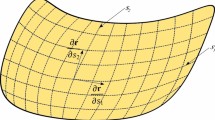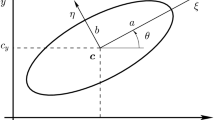Abstract
The calculation of the minimum distance between surfaces plays an important role in computational mechanics, namely, in the study of constrained multibody systems where contact forces take part. In this paper, a general rigid contact detection methodology for non-conformal bodies, described by ellipsoidal and superellipsoidal surfaces, is presented. The mathematical framework relies on simple algebraic and differential geometry, vector calculus, and on the C2 continuous implicit representations of the surfaces. The proposed methodology establishes a set of collinear and orthogonal constraints between vectors defining the contacting surfaces that, allied with loci constraints, which are specific to the type of surface being used, formulate the contact problem. This set of non-linear equations is solved numerically with the Newton–Raphson method with Jacobian matrices calculated analytically. The method outputs the coordinates of the pair of points with common normal vector directions and, consequently, the minimum distance between both surfaces. Contrary to other contact detection methodologies, the proposed mathematical framework does not rely on polygonal-based geometries neither on complex non-linear optimization formulations. Furthermore, the methodology is extendable to other surfaces that are (strictly) convex, interact in a non-conformal fashion, present an implicit representation, and that are at least C2 continuous. Two distinct methods for calculating the tangent and binormal vectors to the implicit surfaces are introduced: (i) a method based on the Householder reflection matrix; and (ii) a method based on a square plate rotation mechanism. The first provides a base of three orthogonal vectors, in which one of them is collinear to the surface normal. For the latter, it is shown that, by means of an analogy to the referred mechanism, at least two non-collinear vectors to the normal vector can be determined. Complementarily, several mathematical and computational aspects, regarding the rigid contact detection methodology, are described. The proposed methodology is applied to several case tests involving the contact between different (super) ellipsoidal contact pairs. Numerical results show that the implemented methodology is highly efficient and accurate for ellipsoids and superellipsoids.
Similar content being viewed by others
Explore related subjects
Discover the latest articles and news from researchers in related subjects, suggested using machine learning.References
Nikravesh, P.: Computer-Aided Analysis of Mechanical Systems. Prentice Hall, Englewood Cliffs (1988)
Barr, A.H.: Superquadrics and angle-preserving transformations. IEEE Comput. Graph. Appl. 1(1), 11–23 (1981)
Li, C.L.: Part segmentation by superquadric fitting—a new approach towards automatic design of cooling system for plastic injection mould. Int. J. Adv. Manuf. Technol. 35, 102–114 (2007)
Bardinet, E., Cohen, L.D., Ayache, N.: Superquadrics and free-form deformations: a global model to fit and track 3D medical data. Lecture Notes in Computer Science, vol. 905, pp. 319–326. Springer, Berlin (1996)
Schwertassek, R., Klisch, T.: Two modelling problems in multibody simulation: flexible bodies and contact of bodies. In: Proceedings of the NATO Advanced Study Institute on Computational Methods in Mechanisms, Invited Lectures, 1, Varna, Bulgaria, 1997, pp. 283–312
Pombo, J., Ambrósio, J., Silva, M.: A new wheel-rail contact model for railway dynamics Veh. Syst. Dyn. 45(2), 165–189 (2007)
Fallahi, B., Ballamudi, S.K.: Computation of common normal between wheel and rail surfaces. In: Proceedings of the 1st Joint International Conference on Multibody System Dynamics, May 25–27, Lappeenranta, Finland, 2010
Hertz, H.: On the contact of solids—on the contact of rigid elastic solids and on hardness (Translated by D. E. Jones and G. A. Schott), Miscellaneous Papers. MacMillan, London (1896), 146-183
Lankarani, H., Nikravesh, P.: Continuous contact force models for impact analysis in multibody systems. Nonlinear Dyn. 5, 193–207 (1994)
Hunt, K., Crossley, F.: Coefficient of restitution interpreted as damping in vibroimpact. ASME J. Appl. Mech. 42, 440–445 (1975)
Flores, P., Leice, R., Glocker, C.: Modeling and analysis of planar rigid multibody systems with translational clearance joints based on the non-smooth dynamics approach. Multibody Syst. Dyn. 23(2), 165–190 (2010)
Donev, A., Torquato, S., Stillinger, F.H.: Neighbor list collision-driven molecular dynamics simulation for nonspherical hard particles. II. Applications to ellipses and ellipsoids. J. Comput. Phys. 202, 765–793 (2005)
Lin, X., Ng, T.-T.: Contact detection algorithms for three-dimensional ellipsoids in discrete element modelling. Int. J. Numer. Anal. Methods Geomech. 19, 653–659 (1995)
Kwak, S.D., Blankevoort, L., Ateshian, G.A.: A mathematical formulation for 3D quasi-static multibody models of diarthrodial joints. Comput. Methods Biomech. Biomed. Eng. 3, 41–649 (2000)
Liu, S., Wang, C.C.L., Hui, K.-C., Jin, X., Zhao, H.: Ellipsoid-tree construction for solid objects, In: Proceedings of the 2007 ACM Symposium on Solid and Physical Modeling, Beijing, China, pp. 303–308, 2007
Chakraborty, N., Peng, J., Akella, S., Mitchell, J.: Proximity queries between convex objects: an interior point approach for implicit surfaces. In: Proceedings of the IEEE International Conference on Robotics and Automation, 1910–1916, 2006
Wang, W., Wang, J., Kim, M.-S.: An algebraic condition for the separation of two ellipsoids. Comput. Aided Geom. Des. 18(6), 531–539 (2001)
Choi, Y.-K., Chang, J.-W., Wang, W., Kim, M.-S., Elber, G.: Continuous collision detection for ellipsoids. IEEE Trans. Vis. Comput. Graph. 15(2), 311–325 (2009)
Wellmann, C., Lillie, C., Wriggers, P.: A contact detection algorithm for superellipsoids based on the common-normal concept. Eng. Comput. 25(5), 432–442 (2008)
García de Jalón, J., Bayo, E.: Kinematic and Dynamic Simulation of Multibody Systems: The Real Time Challenge. Springer, New York (1994)
Portal, R.F., Sousa, L.G., Dias, J.P.: Contact detection of convex superquadrics using optimization techniques with graphical user interface. In: Proceedings of the 7th EUROMECH Solid Mechanics Conference, Lisboa, Portugal, 2009
Bazaraa, M.S., Sherali, H.D., Shetty, C.M.: Nonlinear Programming: Theory and Algorithms. Wiley, Hoboken (1993)
Grosan, A., Abraham, A.: A new approach for solving nonlinear equations systems. IEEE Trans. Syst. Man. Cybern., Part A, Syst. Humans 38(3), 689–714 (2008)
Moustakas, K., Tzovaras, D., Strintzis, M.G.: SQ-map: efficient layered collision detection and haptic rendering. In: IEEE Trans. Vis. Comput. Graph., pp. 80–93, 2007
Atkinson, K., Han, W.: Theoretical numerical analysis: a functional analysis framework, 2nd edn., Springer Texts in Applied Mathematics, Springer, Berlin (2005)
Householder, A.S.: Unitary triangularization of a nonsymmetric matrix. J. Assoc. Comput. Mach. 4(5), 339–342 (1958)
Jaklic, A., Leonardis, A., Solina, F.: Segmentation and Recovery of Superquadrics Computational Imaging and Vision, vol. 20, Kluwer, Dordrecth (2000)
MDC-ELLIPSOIDs v1.0—Minimum distance calculation between ellipsoids described as implicit surfaces. http://web.ist.utl.pt/daniel.s.lopes/mdc-ellipsoids.html
Author information
Authors and Affiliations
Corresponding author
Rights and permissions
About this article
Cite this article
Lopes, D.S., Silva, M.T., Ambrósio, J.A. et al. A mathematical framework for rigid contact detection between quadric and superquadric surfaces. Multibody Syst Dyn 24, 255–280 (2010). https://doi.org/10.1007/s11044-010-9220-0
Received:
Accepted:
Published:
Issue Date:
DOI: https://doi.org/10.1007/s11044-010-9220-0




